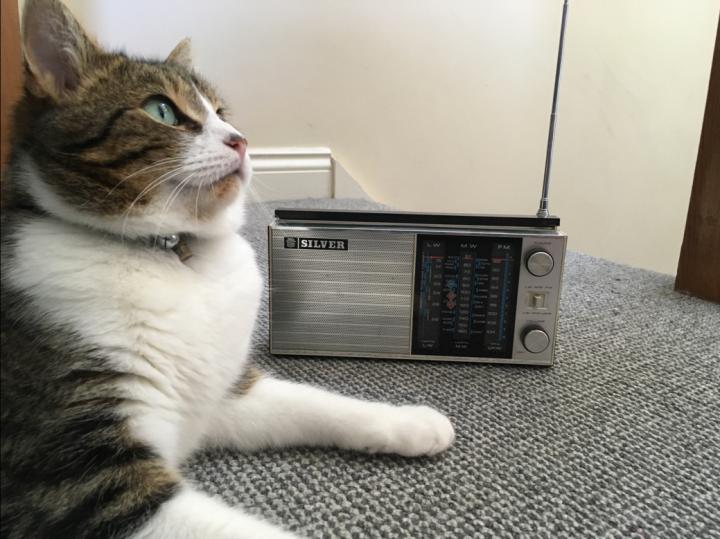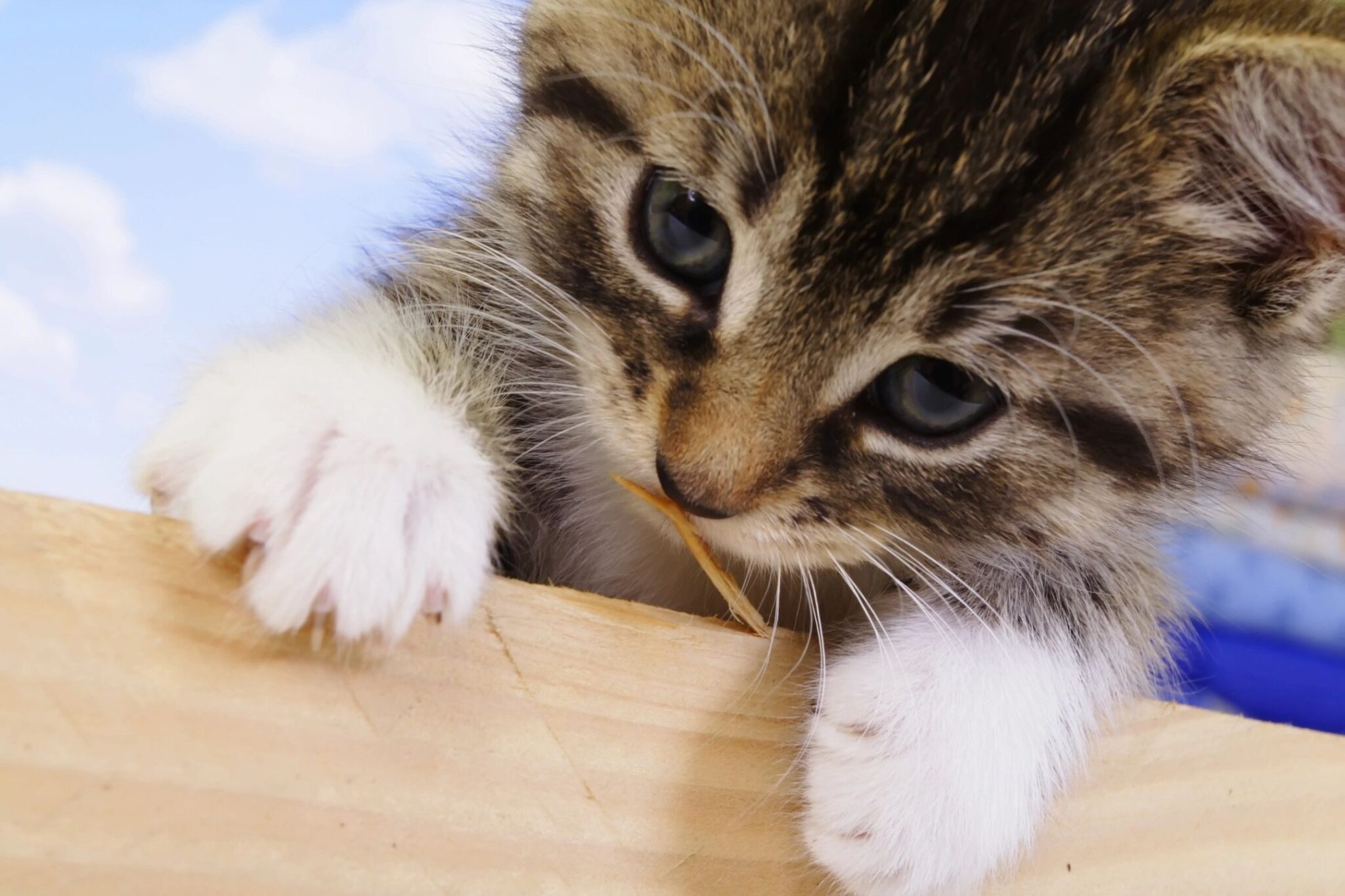Cats in a new study showed lower stress responses while listening to a certain type of music, which could help vet visits be less stressful.
By Jocelyn Solis-Moreira
If you had to paint a picture of a cat’s worst nightmare, it might include dogs, water, or a trip to the vet. In fact, if you were to ask a cat owner about their worst nightmare, it might be trying to get their furry friend to the vet.
Good news for all cat owners: a study shows that music specifically designed for cats may calm them in stressful situations. Ronald Koh and colleagues at Louisiana State University School of Veterinary Medicine studied how cats’ physiological and behavioral responses changed while listening to different types of music during veterinary checkups.
How does music help with our stress?
Studies have shown that music affects people on emotional and physical levels. After facing a stressful event, music listeners’ cortisol levels decreased at a faster rate than those of people who recovered in silence. By lowering our cortisol levels, we lower our stress and anxiety.
Music’s therapeutic effect on stress has also been applied in various treatments for veterans with post-traumatic stress disorder, people with type 2 diabetes, and people with Alzheimer’s disease. Listening to music has also been used as a stress-reducing technique for patients undergoing cancer treatments and diagnostic procedures such as PET scans. Different types of music have been shown to evoke different physiological responses in people when facing stressors. In a human study, participants who faced a stressful event recovered faster when listening to classical music or to their own music preferences compared with those left in silence.

What is the purr-fect music for cats?
Cats in Koh’s study who listened to cat-specific music during wellness visits to a veterinarian were less stressed—physically and emotionally—compared with cats that had their checkups in silence or with classical music playing. The study enrolled 20 cats, aged 10 years or younger. Cats were randomly assigned to 20 minutes of one of three sound alternatives during one of three video-recorded physical exams by the veterinarian, each scheduled two weeks apart. The researchers used cat-specific music composed with cat vocalizations such as purring and suckling. They tested which sound experience was most effective in reducing cats’ stress levels: cat-specific music, classical music, or no music. The researchers observed that just like humans, cats prefer music containing a beat similar to their resting pulse rate; they also prefer specific cat-related sounds and frequencies within their vocal range.
RELATED: SIMON’S CAT LOGIC: WHY DO CATS HAVE A “CRAZY TIME”?
How do we measure stress?
One common way to measure stress is through assessing a bodily response that occurs after encountering a stressor. Neutrophil–lymphocyte ratios can describe a physical stress response, as stress directly alters the body’s immune system. Neutrophils are white blood cells used as a first-line defense against infection, inflammation, and stress; lymphocytes are another type of white blood cells, classified as B lymphocytes or T lymphocytes. B lymphocytes produce antibodies to fight infections, while T lymphocytes identify and destroy foreign invaders such as virus-infected cells and cancer cells. Acute stress can be measured by the neutrophil–lymphocyte ratio. The stress hormone cortisol has been shown to increase the number of neutrophils while simultaneously decreasing the number of lymphocytes in the body—making it harder to stave off prolonged infection.
Researchers in Koh’s study took blood samples from the cats to measure neutrophil–lymphocyte ratios. They observed behavioral responses to measure stress, and assessed cat behavior on scales for stress-related behavior and handling behavior. Stress scores were determined when the cat entered the examination room, before the cat was taken out of the carrier, during the physical exam, and when the cat was placed back into the carrier. Handling scores were recorded according to the cat’s reaction to being moved by the handler in and out of the carrier.
Behavioral results showed less stress-related behavior in cats listening to cat-specific music compared with classical music or no music. However, researchers noted no difference in physiological stress response when comparing a cat’s neutrophil–lymphocyte ratios under all three sound conditions. The researchers attributed this to an insufficient length of music exposure, since 20 minutes may not have been long enough to affect the blood profiles of stressed cats.
RELATED: SIMON’S CAT LOGIC: WHAT YOU DIDN’T KNOW ABOUT MEAL TIME
Why is cat-specific music important?
Environmental enrichment for cats, such as toys, climbing structures, window perches, and bird videos, has been shown to reduce stress behavior such as fearfulness and aggression and to reduce urinary tract issues. Adding cat-specific music as an environmental modification offers a potential solution for cat owners trying to acclimate their pets to new areas and people.

Providing cat-specific music during wellness exams can increase a veterinarian’s ability to give quality care to a cat. In turn, pet owners can feel more confident of their pet’s welfare. Because this experiment focused mainly on shorter periods of stress, Koh and colleagues suggest that future studies should investigate the behavioral and physiological impacts of cat-specific music in prolonged veterinary hospitalization.
This study was published in the Journal of Feline Medicine and Surgery.
References
Bensimon, M., Amir, D., & Wolf, Y. (2008). Drumming through trauma: Music therapy with post-traumatic soldiers. The Arts in Psychotherapy, 35(1), 34–48.
Bradt, J., Dileo, C., Magill, L., & Teague, A. (2016). Music interventions for improving psychological and physical outcomes in cancer patients. Cochrane Database of Systematic Reviews, 8.
Buffington, C. A., Westropp, J. L., Chew, D. J., & Bolus, R. R. (2006). Clinical evaluation of multimodal environmental modification (MEMO) in the management of cats with idiopathic cystitis. Journal of Feline Medicine and Surgery, 8, 261–268.
Hampton, A., Ford, A., Cox, R. E., III, Liu, C., Koh, R. (2019). Effects of music on behavior and physiological stress response of domestic cats in a veterinary clinic. Journal of Feline Medicine and Surgery, 22(2), 122–128.
Khalfa, S., Bella, S. D., Roy, M., Peretz, I., & Lupien, S. J. (2003). Effects of relaxing music on salivary cortisol level after psychological stress. Annals of the New York Academy of Sciences, 999, 374–376.
Labbé, E., Schmidt, N., Babin, J., & Pharr, M. (2007). Coping with stress: The effectiveness of different types of music. Applied Psychophysiology and Biofeedback, 32(3–4), 163–168.
Lee, W. L., Sung, H. C., Liu, S. H., & Chang, S. M. (2016). Meditative music listening to reduce state anxiety in patients during the uptake phase before positron emission tomography (PET) scans. British Journal of Radiology, 90. https://doi.org/10.1259/bjr.20160466
Tumuluri, I., Hegde, S., & Nagendra, H. R. (2017). Effectiveness of music therapy on focused attention, working memory and stress in type 2 diabetes: An exploratory study. International Journal of Yoga, 10(3), 167.
—Jocelyn Solis-Moreira is an aspiring science journalist and writer who currently works in academic publishing. She holds a master’s degree in neuroscience and enjoys reporting on the latest research discoveries and writing about them in a digestible and enjoyable format. Connect with her via Twitter @ScienceSaiyan.




